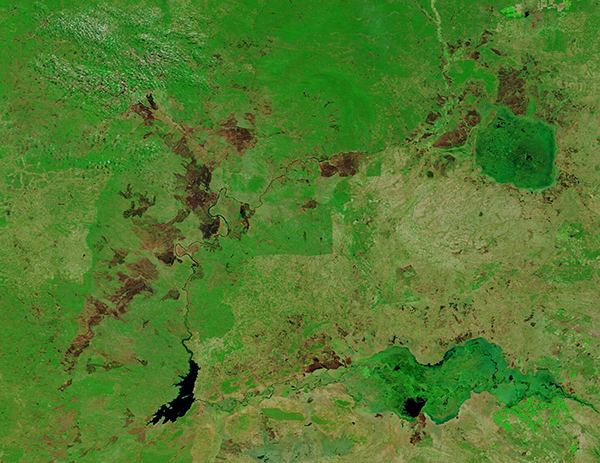Images
June 19, 2023 - Burn Scars near Kafue National Park, Zambia
Tweet
Multiple large burn scars covered verdant green savanna grasslands near in west-central Zambia in mid-June 2023. The Moderate Resolution Imaging Spectroradiometer (MODIS) on NASA’s Terra satellite acquired this false-color image located near Kafue National Park on June 14.
This type of false-color image uses infrared and visible light to help separate vegetation, which appears bright green, from water (deep inky blue) and burn scars. Such scars are left after fire scorches an area, and their color can vary from brick red to light brown or black depending on several factors including how much vegetation remains, how hot the burn was, how long ago the fire burnt the land, and even the color of the soil.
In this image, brick red is the predominant color of the burn scars and suggests they are recently made. In some areas they are very dark, perhaps where vegetation was more completely burned, or the fire became hotter. Orange dots appear along the edges of some of the burnt areas. These are spots indicating actively burning fire. Most of the scars sit in savanna grassland west of the Kafue River and near or in Kafue National Park.
While satellite imagery can’t diagnose why a fire started, given the time of year and the location it is very likely that these scars came from fires set to manage the land. Zambia’s grasslands grow extremely lush in the rainy season, which begins in November and ends in April. Fire is a natural part of this ecosystem and even is necessary to sustain the savanna vegetation which supports both wildlife and human communities. Traditionally, nearly 70 percent of the lands in and around Kafue National Park burn annually, usually at the end of the dry season when vegetation is tinder-ready and air temperatures soar. Under these conditions, wild bush fires can cause devastation over vast areas.
In order to manage and sustain a healthy ecosystem and avoid destructive late dry-season fires, a management technique called “early burning” is practiced in this area, and across much of Zambia. Fires are deliberately set in the early dry season when vegetation still has some moisture. It will burn, but at lower temperatures and without the risk of escape and spread typical of the late dry season. The process of early burning also helps shrubs to sprout vigorously and encourages growth of new grass, both of which provide food for wildlife in the otherwise parched late dry season. As vegetation is renewed in these areas, the scars will fill in and become green. By the early wet season, little trace of the May-through-June early burns will remain to be seen from space.
Image Facts
Satellite:
Terra
Date Acquired: 6/14/2023
Resolutions:
1km (167.8 KB), 500m (428.2 KB), 250m (257.7 KB)
Bands Used: 7.2.1
Image Credit:
MODIS Land Rapid Response Team, NASA GSFC
Tweet
Multiple large burn scars covered verdant green savanna grasslands near in west-central Zambia in mid-June 2023. The Moderate Resolution Imaging Spectroradiometer (MODIS) on NASA’s Terra satellite acquired this false-color image located near Kafue National Park on June 14.
This type of false-color image uses infrared and visible light to help separate vegetation, which appears bright green, from water (deep inky blue) and burn scars. Such scars are left after fire scorches an area, and their color can vary from brick red to light brown or black depending on several factors including how much vegetation remains, how hot the burn was, how long ago the fire burnt the land, and even the color of the soil.
In this image, brick red is the predominant color of the burn scars and suggests they are recently made. In some areas they are very dark, perhaps where vegetation was more completely burned, or the fire became hotter. Orange dots appear along the edges of some of the burnt areas. These are spots indicating actively burning fire. Most of the scars sit in savanna grassland west of the Kafue River and near or in Kafue National Park.
While satellite imagery can’t diagnose why a fire started, given the time of year and the location it is very likely that these scars came from fires set to manage the land. Zambia’s grasslands grow extremely lush in the rainy season, which begins in November and ends in April. Fire is a natural part of this ecosystem and even is necessary to sustain the savanna vegetation which supports both wildlife and human communities. Traditionally, nearly 70 percent of the lands in and around Kafue National Park burn annually, usually at the end of the dry season when vegetation is tinder-ready and air temperatures soar. Under these conditions, wild bush fires can cause devastation over vast areas.
In order to manage and sustain a healthy ecosystem and avoid destructive late dry-season fires, a management technique called “early burning” is practiced in this area, and across much of Zambia. Fires are deliberately set in the early dry season when vegetation still has some moisture. It will burn, but at lower temperatures and without the risk of escape and spread typical of the late dry season. The process of early burning also helps shrubs to sprout vigorously and encourages growth of new grass, both of which provide food for wildlife in the otherwise parched late dry season. As vegetation is renewed in these areas, the scars will fill in and become green. By the early wet season, little trace of the May-through-June early burns will remain to be seen from space.
Image Facts
Satellite:
Terra
Date Acquired: 6/14/2023
Resolutions:
1km (167.8 KB), 500m (428.2 KB), 250m (257.7 KB)
Bands Used: 7.2.1
Image Credit:
MODIS Land Rapid Response Team, NASA GSFC




